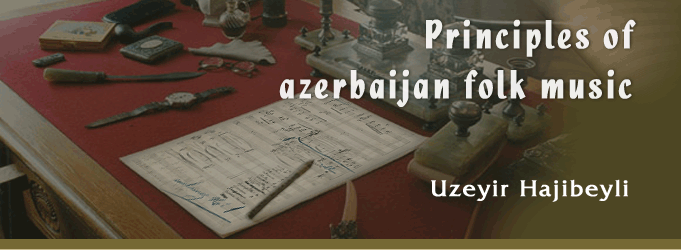

Part two
AUXILIARY MODES
Modes, which scales are structured from the combination of unequal tetrachords, are called auxiliary modes.
The following modes are considered to be auxiliary modes in Azerbaijani music: 1)"Chargah" of the second type, 2) "Shakhnaz", and 3) Saranj".
1. Composing music in the mode "Chargah" of the 2-nd type
A. Diapason of the scale "Chargah" of the 2-nd type
If we take a tetrachord structured by formula 1/2 - 11/2 - 1/2 and combine it separately with another tetrachord built by formula 1- 1- 1/2 (mixed combination), we shall get the scale of the mode "Chargah" of the 2-nd type: 1/2- 11/2- 1/2 + 1 - 1 - 1/2
Diapason of the both "Chargah" types' consists of the combination of three tetrachords (lower, medial and upper). Out of them the lower tetrachord is the octave upper. Therefore, the full scale of "Chargah" of the 2-nd type is presented as follows:
B. Mortal functions of degrees and permissible leaps
In the above-given scale:
1-st degree of the scale has a function of the lower quarte. Leaps to the tonic only are allowed from this degree.
2-nd degree of the scale has a function of the lower mediant of the tonic. Leaps to the tonic only are allowed from this scale.
3-rd degree of the scale has a function of the subtonic of the tonic. Leaps to the subtonic of the keynote are allowed.
4-th degree of the scale has a function of the tonic. Leaps from this degree are allowed: upwards - to the third, to the quarte and to the quinte, downwards - to the lower mediant and to the lower quarte.
5-th degree of the scale has a function of the supertonic of the keynote. Leaps from this degree are allowed to the upper quarte of the tonic, but downwards - to the subtonic of the tonic.
6-th degree of the scale has a function of the tonic upper third. Leaps from this degree are allowed: upwards - to the tonic quinte, downwards - to the tonic.
7-th degree of the scale has a function of the tonic upper quarte. Leaps from this degree are allowed: upwards -to the supertonic of the quinte, downwards - to the supertonic of the keynote and to the tonic.
8-th degree of the scale has a function of the tonic quinte. Leaps from this degree are allowed: upwards - to the octave of the tonic, downwards - to the tonic third and to the tonic.
9-th degree of the scale has two functions: 1) supertonic of the quinte, 2) lower mediant of the tonic octave. Leaps from this scale are allowed: upwards - to the tonic octave, downwards - to the upper quarte of the tonic.
10-th degree of the scale has a function of the subtonic of the tonic octave. Leaps are allowed downwards - to the tonic quinte.
11- th degree of the scale has a function of the tonic octave. Leaps from this degree are allowed down to its own lower mediant and to the quinte of the tonic.
C. Table of permissible leaps
D. Full and half cadences
Full and half cadences in the mode "Chargah" of the 2-nd type are the same as for "Chargah" of the 1-st type.
[ Chargah: pages 1 2 ]| Chargah | Shahnaz | Saranj |


